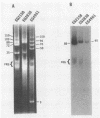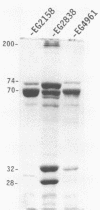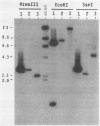Abstract
Two novel strains of Bacillus thuringiensis were isolated from native habitats by the use of genes coding for proteins toxic to coleopterans (cryIII genes) as hybridization probes. Strain EG2838 (isolated by the use of the cryIIIA probe) contained a cryIIIA-hybridizing plasmid of approximately 100 MDa and synthesized crystal proteins of approximately 200 (doublet), 74, 70, 32, and 28 kDa. Strain EG4961 (isolated by the use of a cryIIIA-related probe) contained a cryIIIA-hybridizing plasmid of approximately 95 MDa and synthesized crystal proteins of 74, 70, and 30 kDa. Structural relationships among the crystal proteins of strains EG2838 and EG4961 were detected; antibodies to the CryIIIA protein toxic to coleopterans reacted with the 74- and 70-kDa proteins of EG2838 and EG4961, antibodies to the 32-kDa plus 28-kDa proteins of EG2838 reacted with the 30-kDa protein of EG4961, and antibodies to the 200-kDa proteins of EG2838 reacted with the 28-kDa protein of EG2838. Experiments with B. thuringiensis flagella antibody reagents demonstrated that EG2838 belongs to H serotype 9 (reference strain B. thuringiensis subsp. tolworthi) and that EG4961 belongs to H serotype 18 (reference strain B. thuringiensis subsp. kumamotoensis). A mixture of spores plus crystal proteins of either EG2838 or EG4961 was toxic to the larvae of Colorado potato beetle (Leptinotarsa decemlineata), and significantly, the EG4961 mixture was also toxic to the larvae of southern corn rootworm (Diabrotica undecimpunctata howardi). DNA restriction blot analysis suggested that strains EG2838 and EG4961 each contained a unique gene coding for a protein toxic to coleopterans.
Full text
PDF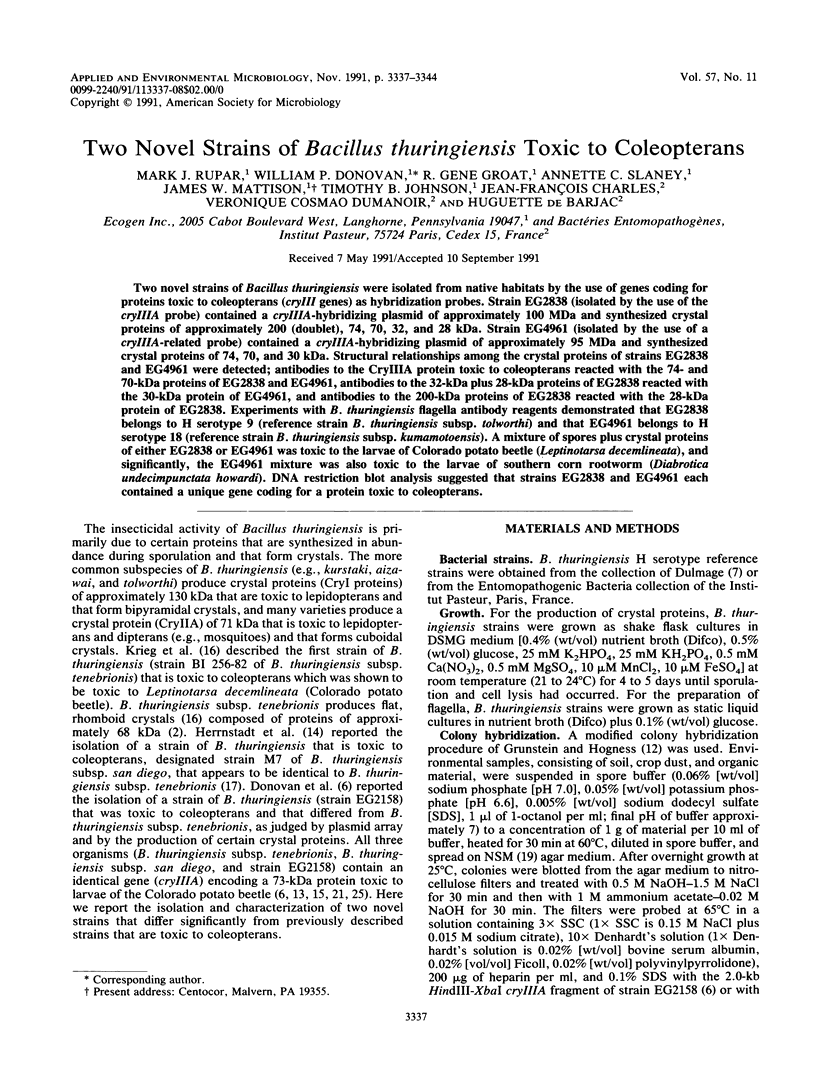

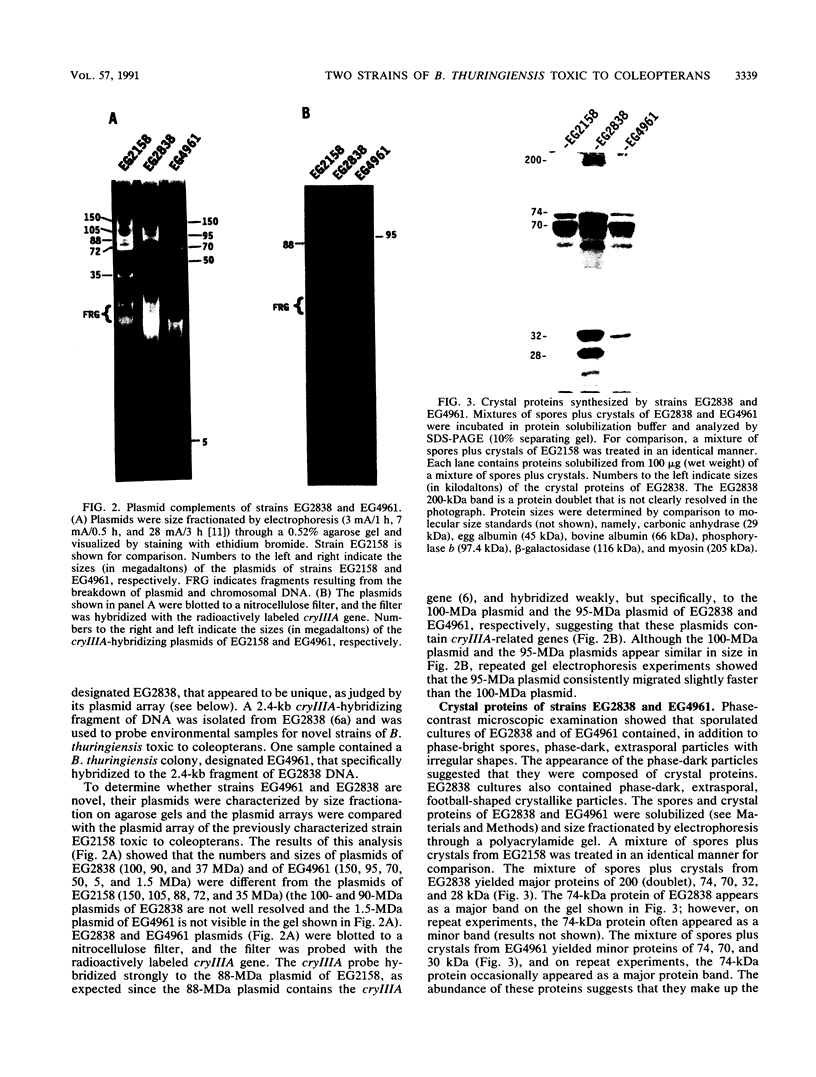
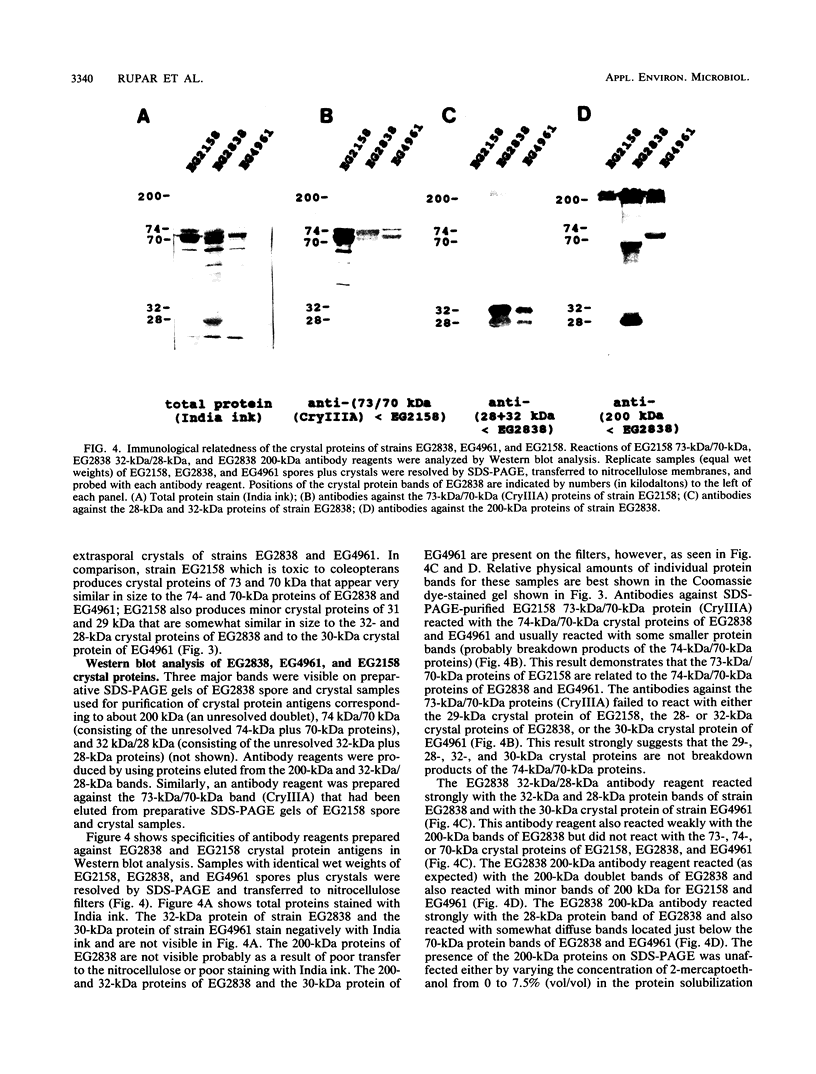
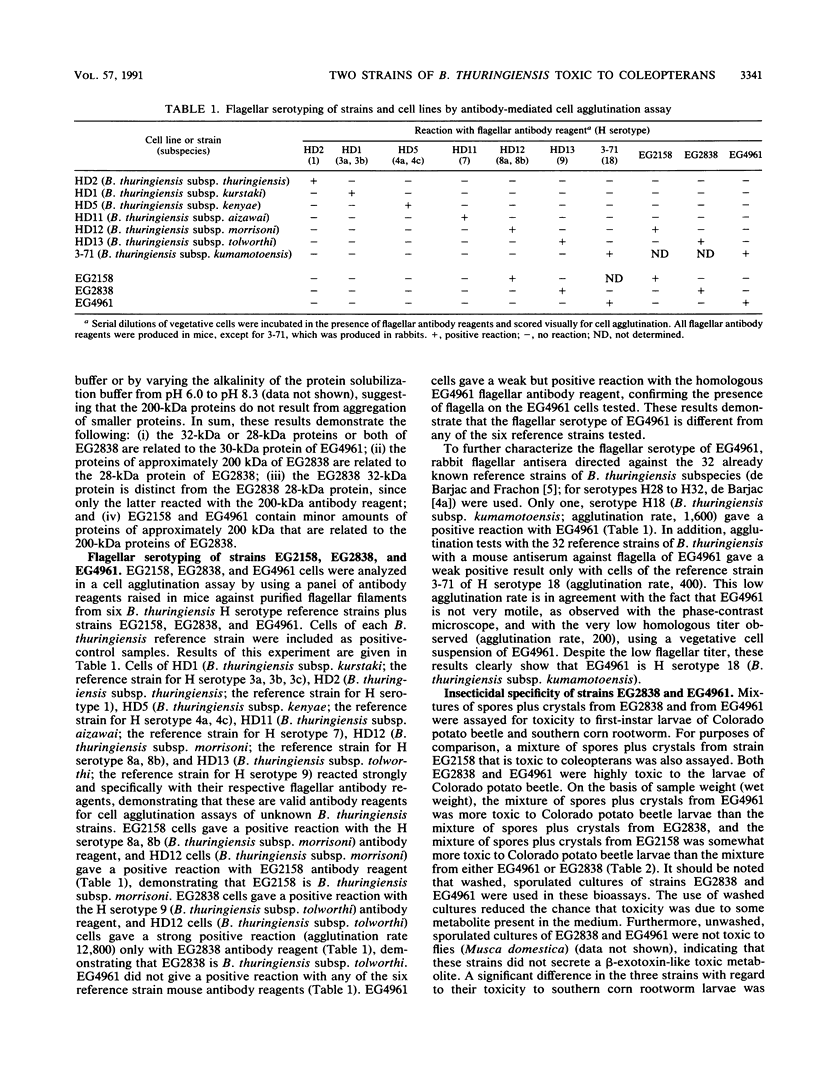

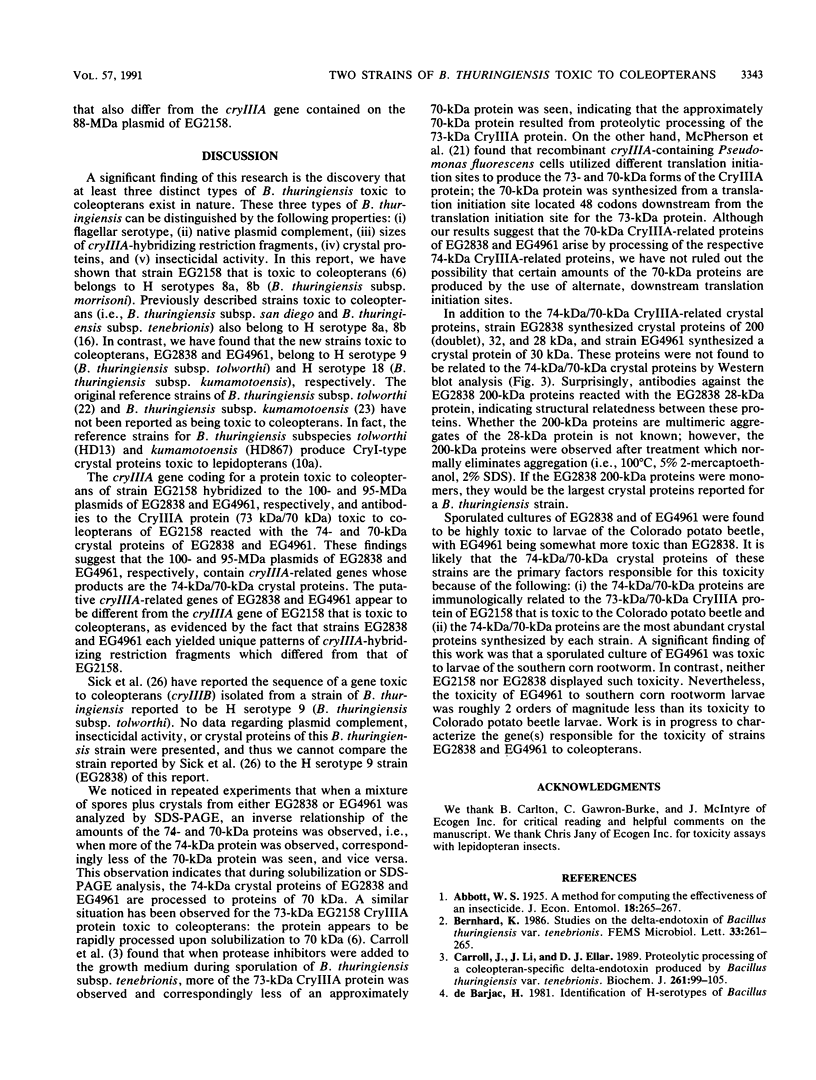
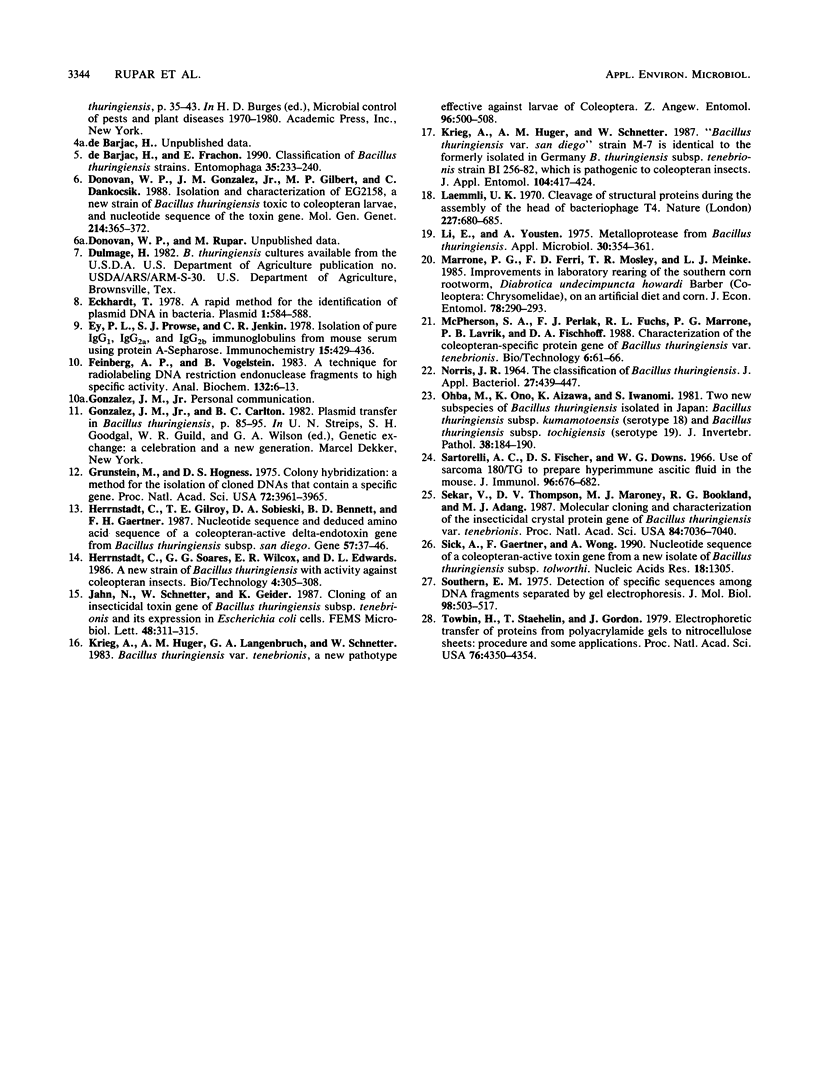
Images in this article
Selected References
These references are in PubMed. This may not be the complete list of references from this article.
- Carroll J., Li J., Ellar D. J. Proteolytic processing of a coleopteran-specific delta-endotoxin produced by Bacillus thuringiensis var. tenebrionis. Biochem J. 1989 Jul 1;261(1):99–105. doi: 10.1042/bj2610099. [DOI] [PMC free article] [PubMed] [Google Scholar]
- Donovan W. P., Gonzalez J. M., Jr, Gilbert M. P., Dankocsik C. Isolation and characterization of EG2158, a new strain of Bacillus thuringiensis toxic to coleopteran larvae, and nucleotide sequence of the toxin gene. Mol Gen Genet. 1988 Nov;214(3):365–372. doi: 10.1007/BF00330468. [DOI] [PubMed] [Google Scholar]
- Eckhardt T. A rapid method for the identification of plasmid desoxyribonucleic acid in bacteria. Plasmid. 1978 Sep;1(4):584–588. doi: 10.1016/0147-619x(78)90016-1. [DOI] [PubMed] [Google Scholar]
- Ey P. L., Prowse S. J., Jenkin C. R. Isolation of pure IgG1, IgG2a and IgG2b immunoglobulins from mouse serum using protein A-sepharose. Immunochemistry. 1978 Jul;15(7):429–436. doi: 10.1016/0161-5890(78)90070-6. [DOI] [PubMed] [Google Scholar]
- Feinberg A. P., Vogelstein B. A technique for radiolabeling DNA restriction endonuclease fragments to high specific activity. Anal Biochem. 1983 Jul 1;132(1):6–13. doi: 10.1016/0003-2697(83)90418-9. [DOI] [PubMed] [Google Scholar]
- Grunstein M., Hogness D. S. Colony hybridization: a method for the isolation of cloned DNAs that contain a specific gene. Proc Natl Acad Sci U S A. 1975 Oct;72(10):3961–3965. doi: 10.1073/pnas.72.10.3961. [DOI] [PMC free article] [PubMed] [Google Scholar]
- Herrnstadt C., Gilroy T. E., Sobieski D. A., Bennett B. D., Gaertner F. H. Nucleotide sequence and deduced amino acid sequence of a coleopteran-active delta-endotoxin gene from Bacillus thuringiensis subsp. san diego. Gene. 1987;57(1):37–46. doi: 10.1016/0378-1119(87)90174-0. [DOI] [PubMed] [Google Scholar]
- Laemmli U. K. Cleavage of structural proteins during the assembly of the head of bacteriophage T4. Nature. 1970 Aug 15;227(5259):680–685. doi: 10.1038/227680a0. [DOI] [PubMed] [Google Scholar]
- Li E., Yousten A. A. Metalloprotease from Bacillus thuringiensis. Appl Microbiol. 1975 Sep;30(3):354–361. doi: 10.1128/am.30.3.354-361.1975. [DOI] [PMC free article] [PubMed] [Google Scholar]
- Sartorelli A. C., Fischer D. S., Downs W. G. Use of sarcoma 180/TG to prepare hyperimmune ascitic fluid in the mouse. J Immunol. 1966 Apr;96(4):676–682. [PubMed] [Google Scholar]
- Sekar V., Thompson D. V., Maroney M. J., Bookland R. G., Adang M. J. Molecular cloning and characterization of the insecticidal crystal protein gene of Bacillus thuringiensis var. tenebrionis. Proc Natl Acad Sci U S A. 1987 Oct;84(20):7036–7040. doi: 10.1073/pnas.84.20.7036. [DOI] [PMC free article] [PubMed] [Google Scholar]
- Sick A., Gaertner F., Wong A. Nucleotide sequence of a coleopteran-active toxin gene from a new isolate of Bacillus thuringiensis subsp. tolworthi. Nucleic Acids Res. 1990 Mar 11;18(5):1305–1305. doi: 10.1093/nar/18.5.1305. [DOI] [PMC free article] [PubMed] [Google Scholar]
- Southern E. M. Detection of specific sequences among DNA fragments separated by gel electrophoresis. J Mol Biol. 1975 Nov 5;98(3):503–517. doi: 10.1016/s0022-2836(75)80083-0. [DOI] [PubMed] [Google Scholar]
- Towbin H., Staehelin T., Gordon J. Electrophoretic transfer of proteins from polyacrylamide gels to nitrocellulose sheets: procedure and some applications. Proc Natl Acad Sci U S A. 1979 Sep;76(9):4350–4354. doi: 10.1073/pnas.76.9.4350. [DOI] [PMC free article] [PubMed] [Google Scholar]



